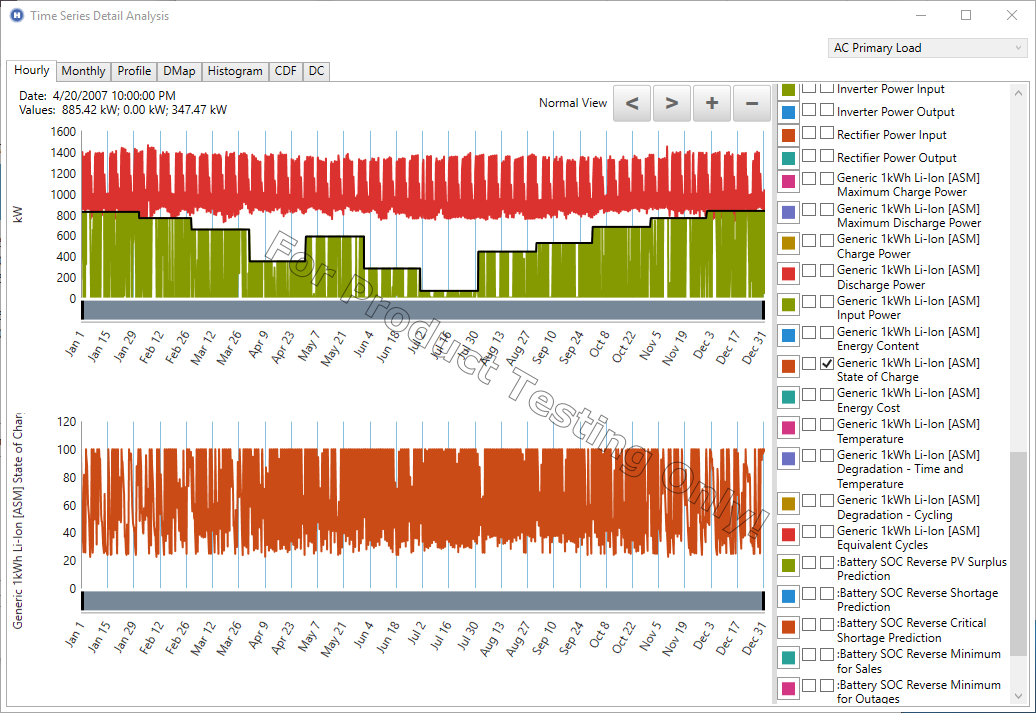
HOMER Grid 1.10

![]()
The HOMER Grid dispatch strategy makes decisions in each time step that determine how to use the system's components for demand charge reduction and energy arbitrage while serving the electric load.
Demand Limit
Grid charges can be categorized into energy charges, demand charges and fixed charges. Energy charge is the cost ($/kWh) of consumption. Demand charge is the cost ($/kW) of demand. Demand charges are the utility’s way of discouraging sudden spikes in demand. Peak shaving or demand charge reduction aims to reduce a customer's electricity bill by reducing these demand charges. To reduce demand charges, HOMER Grid will try to limit the peak power purchased during each month.
Observe the graph below: (Electric load = red; Grid purchases = green; demand limit = black; State of Charge = orange)

The demand limit is an artificial limit that restricts the maximum allowable grid purchase. In the above graph, observe that the green lines (grid purchases) do not exceed the black line (demand limit). HOMER Grid varies the demand limit on a monthly basis. One of the objectives of the HOMER Grid control strategy is optimizing the demand limit in every month to achieve maximum reduction in demand charges. As shown on the second axis, HOMER Grid will strategically discharge batteries to lower the monthly demand charge.
Dispatch
The dispatch algorithm is responsible for deciding in each time step on how the electrical load is served by the available electric generation sources. Among the many decisions it takes, it decides if the battery should be charged by the grid, if it makes sense to buy from the grid, and/or if it should run the generator. The dispatch in HOMER Grid has ‘48-hour look-ahead’, meaning that it knows:
•The electric demand for each time step in the future
•The utility rate schedule
•PV production for each time step in the future
HOMER Grid will optimize and find the least cost system by reducing demand charges and engaging in energy arbitrage if viable. Along with optimizing the sizes of components, HOMER Grid optimizes demand limits for every month. For a given system configuration and size, the Optimizer tries to find the lowest cost grid power demand limit for each month. This often is the lowest peak demand that will, when combined with the PV, storage, and generator, still serve the facility’s electrical load. For systems with a generator, the tradeoff between generator operating costs and reduced grid charges is considered.
If this system is feasible, meaning the electrical demand is being served in each time step without exceeding the peak demand limit, the economics of the system are calculated. The system will get ranked in order of NPC in the final results table.
The dispatch looks two days (48 hours) into the future in each time step when making a dispatch decision. It looks ahead to see if there could be a capacity shortage in the next 48 hours and adjusts its dispatch decision to avoid it if possible. This could involve buying more power from the grid to charge the battery extra during the current time step or turning on the generator to charge the battery even more. It also looks ahead for surplus PV energy (times when the PV output power is greater than the load) and tries to leave headroom in the battery to capture this surplus if it can.
Finally, when arbitrage is feasible, the dispatcher generally prefers offsetting grid purchases to outright selling of battery energy. For example, the dispatcher would prefer to serve all the load from the battery during a period of expensive grid prices rather than selling all the battery right away.
If the system includes a CHP generator and a thermal load, the dispatch evaluates the cost of supplying head from the available sources (electric heater, boiler and CHP generator), and chooses the lowest cost combination.
Tip: You are required to include a boiler if you have a thermal load, and the boiler has unlimited capacity. If you want the controller to not use the boiler at all, you can choose a very high price for the boiler’s fuel. If you have a generator, be sure to use a different fuel for the generator than for the boiler. The LCOE reported in the results tables will be wrong if you use this workaround.
